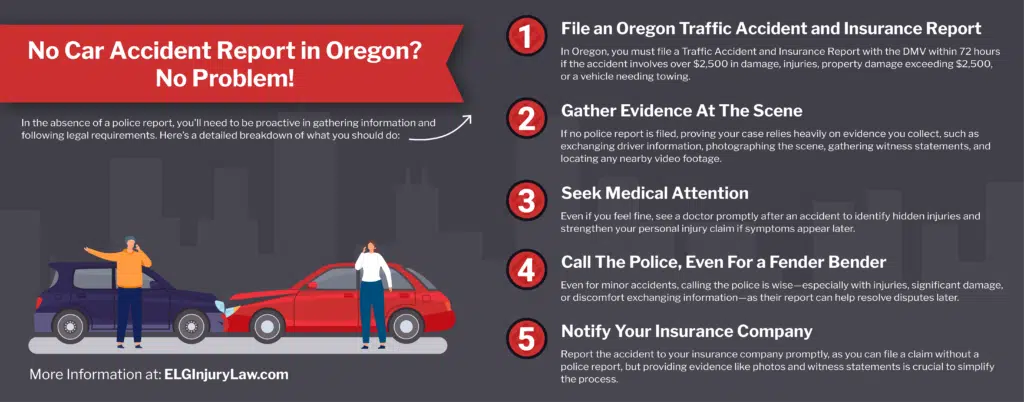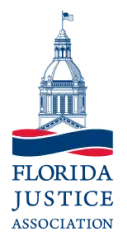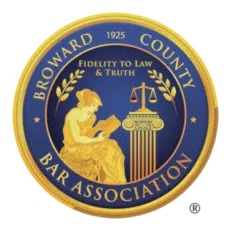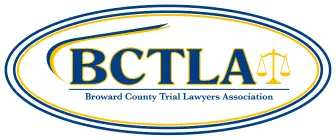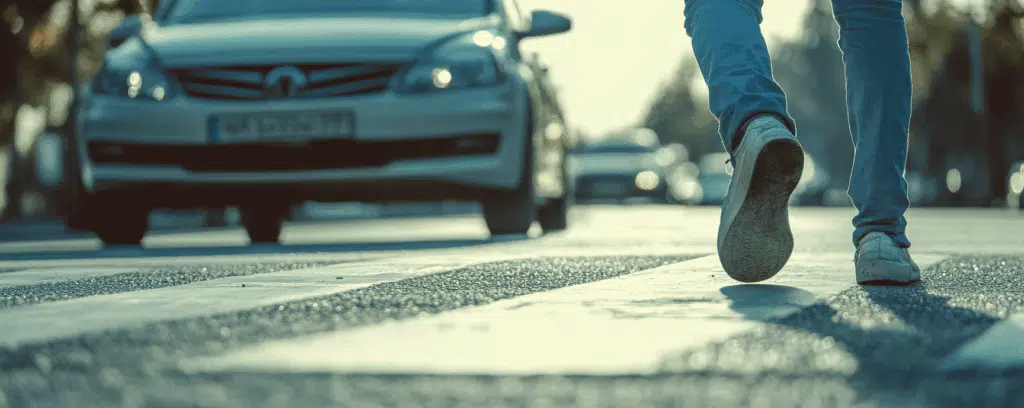
Can a pedestrian sue if hit by a car? Absolutely. Pedestrians have legal rights to claim compensation for injuries and damages. This article will guide you through your legal options, how to establish fault, and what steps to take following the accident to secure your claim.
Key Takeaways
- Pedestrians have legal rights to seek compensation for injuries and damages after a car accident, including claims for medical expenses and lost wages.
- Determining fault in pedestrian-car accidents involves analyzing both the driver’s and pedestrian’s actions, with comparative negligence potentially affecting compensation.
- Immediate steps after an accident, such as seeking medical attention and gathering evidence, are crucial for building a successful personal injury claim.
Legal Rights of Pedestrians in Car Accidents
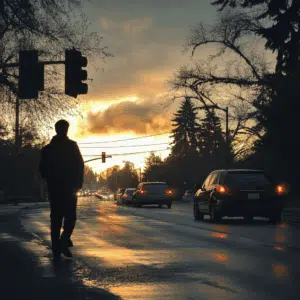 Pedestrians possess distinct legal rights in car accidents, and being aware of these can be empowering. If you are a pedestrian hit by a car, you have the right to seek compensation for your injuries and damages, including pedestrian accident claims. This compensation can cover medical expenses, lost wages, and even emotional distress. In some tragic cases, where pedestrian fatalities occur, certain family members may file wrongful death claims.
Pedestrians possess distinct legal rights in car accidents, and being aware of these can be empowering. If you are a pedestrian hit by a car, you have the right to seek compensation for your injuries and damages, including pedestrian accident claims. This compensation can cover medical expenses, lost wages, and even emotional distress. In some tragic cases, where pedestrian fatalities occur, certain family members may file wrongful death claims.
Proving the driver’s negligence is essential to pursue a personal injury lawsuit. Negligence could be anything from distracted driving to failing to yield the right of way, which pedestrians have in many circumstances.
The success of your lawsuit can depend on various factors, including the circumstances of the accident and the evidence available. Gathering detailed evidence and consulting with a pedestrian accident lawyer is crucial. If you are wondering, “Can a pedestrian sue?” it’s important to understand your rights.
Pedestrians can also file claims using the driver’s motor vehicle insurance policy with the driver’s insurance company. While this might seem straightforward, insurance companies often dispute claims and require substantial evidence to process them. Understanding these legal rights and navigating the legal system effectively can significantly impact your ability to receive fair compensation if a pedestrian suit occurs.
Determining Fault in Pedestrian-Car Accidents
Evaluating the actions of both the driver and the pedestrian is crucial in determining fault in pedestrian-car accidents. Drivers are required to operate their vehicles safely, remain aware of their surroundings, and yield to pedestrians. However, pedestrians also have a responsibility to adhere to traffic laws, such as using designated crosswalks and obeying traffic signals, which includes understanding the pedestrian’s role in these situations.
The determination of fault can vary by state and is influenced by various factors, including traffic lights and signals, the actions of both parties, and the context in which the accident occurred. Proving driver negligence involves showing that the driver failed to meet their duty of care, supported by evidence such as witness statements, police reports, and photographs from the accident scene to establish fault.
If a pedestrian’s negligence, such as jaywalking or ignoring traffic signals, contributed to the accident, this could affect their liability and reduce their potential damage award. Therefore, collecting comprehensive evidence and possibly seeking the help of an experienced personal injury attorney can be crucial in establishing fault and securing compensation.
Let's Settle For More... Get Your FREE Case Review Today.
Let's Settle For More... Get Your FREE Case Review Today.
Steps to Take After Being Hit by a Car
Immediate action after being hit by a car is critical for both your safety and building a strong personal injury claim. Your actions can significantly affect the outcome of your case.
These steps include seeking medical attention, gathering evidence at the accident scene, and contacting a personal injury lawyer to guide you through the legal process.
Seek Medical Attention Immediately
The first critical step after a pedestrian-car accident is seeking medical attention immediately. Even if you feel fine or think your injuries are minor, calling 911 and getting a medical evaluation is essential. Some injuries, such as internal bleeding or traumatic brain injuries, may not show immediate symptoms but can be life-threatening if left untreated.
Prompt medical evaluation is crucial not only for your health but also for documenting your injuries, which is vital for any personal injury claim. Medical records serve as critical evidence to support your case and can significantly influence the amount of compensation you receive. Never underestimate the importance of immediate medical attention.
Gather Evidence at the Accident Scene
After ensuring your safety and receiving medical attention, gathering evidence at the accident scene is the next crucial step. Police reports, witness testimonies, and photographs can be instrumental in establishing fault. Take photos of the accident scene, the involved vehicles, and any visible injuries you have sustained.
Thorough documentation, including noting the time, date, and conditions at the scene, can strengthen your personal injury claim. All the evidence will be invaluable when you discuss your case with a pedestrian accident lawyer and can help you build a strong case for compensation.
Contact a Personal Injury Lawyer
After gathering evidence, it’s crucial to contact a personal injury lawyer who specializes in pedestrian accidents. An experienced personal injury attorney can offer the legal guidance you need and represent your interests effectively. They can help you understand the compensation process and improve your chances of a successful claim.
If your claim is denied or you are offered an inadequate settlement, a personal injury lawyer can navigate the dispute and pursue fair compensation on your behalf. Consulting with a lawyer provides professional support throughout the legal process, reducing stress and increasing the likelihood of a favorable outcome.
Types of Damages Pedestrians Can Claim
Pedestrians involved in car accidents can claim different types of damages to cover their losses. These include economic, non-economic, and sometimes punitive damages. Economic damages cover quantifiable costs such as medical expenses, lost wages, physical therapy, and travel expenses related to the accident.
Non-economic damages refer to losses that are not easily quantifiable. These include non-economic damages, pain and suffering, emotional distress, and loss of enjoyment of life.
In cases where the driver’s conduct was particularly egregious, punitive damages may also be pursued to punish the driver and deter similar behavior in the future. Legal representation can enhance your chances of securing maximum compensation for all these types of damages.
Common Injuries in Pedestrian-Car Accidents
Common injuries from pedestrian-car accidents include:
- Traumatic brain injuries
- Spinal cord injuries
- Broken bones
- Sprained ligaments
These severe injuries can have long-term consequences, affecting the victim’s quality of life and ability to work.
Seeking medical attention immediately after the accident is crucial, as some injuries may not be immediately apparent. Visiting a healthcare provider ensures that any hidden injuries are diagnosed and treated promptly, important for both your recovery and documenting evidence for your personal injury claim.
Compensatory damages in pedestrian accident cases primarily cover costs related to medical care, lost wages, and pain and suffering. In cases of pedestrian fatalities, relatives may file a wrongful death claim to seek damages for medical bills and funeral expenses.
A personal injury lawyer can help you navigate this process and strengthen your case.
Comparative Negligence in Pedestrian Accidents
Comparative negligence can significantly impact the compensation awarded in pedestrian accidents. In some jurisdictions, if a pedestrian is found partially at fault, their compensation may be reduced based on their degree of fault. For instance, if a pedestrian was distracted or jaywalking, their awarded damages could decrease proportionately to their fault.
In Oregon, the law allows for shared fault, meaning both the pedestrian and the driver can be assigned a percentage of blame. Understanding these laws and their application to your case is crucial for managing expectations and strategizing your legal approach.
An experienced personal injury attorney can offer valuable insights into how comparative negligence laws might affect your claim.
Dealing with Insurance Companies
Handling an insurance company after a pedestrian-car accident can be daunting. Insurance companies often minimize payouts and may dispute fault to avoid compensation. A personal injury lawyer can offer crucial guidance on filing insurance claims, negotiating settlements, and, if necessary, pursuing legal action.
Organized documentation of all correspondence, evidence, and a detailed demand letter outlining your injuries and the compensation you’re seeking is essential for managing your claim effectively. If negotiations fail, consider alternatives like mediation or arbitration before resorting to court action.
Importance of Legal Representation
Legal representation after a pedestrian-car accident is invaluable. A pedestrian accident lawyer can navigate the complex legal processes, ensuring professional and efficient handling of your case. ELG Injury Lawyers, for instance, work on a contingency fee basis, meaning we only get paid if you win your case.
Help from a pedestrian accident lawyer can significantly increase your chances of obtaining fair compensation. We can gather evidence, negotiate with insurance companies, and represent your interests in court if necessary, ensuring you receive the justice you deserve.
Frequently Asked Questions
Can a pedestrian sue if hit by a car?
Yes, a pedestrian can sue if hit by a car, but they must demonstrate that the driver was negligent and that this negligence caused their injuries.
What types of damages can a pedestrian claim?
Pedestrians can claim economic damages, such as medical expenses and lost wages, as well as non-economic damages like pain and suffering. In certain cases, punitive damages may also be pursued to penalize the at-fault party.
How is fault determined in pedestrian-car accidents?
The fault in pedestrian-car accidents is established by assessing the behaviors of both parties involved, along with collecting evidence like witness statements and police reports. This comprehensive evaluation helps determine responsibility in the incident.
What should I do immediately after being hit by a car?
Immediately seek medical attention, gather evidence from the accident scene, and contact a personal injury lawyer for legal guidance.
How can comparative negligence affect my compensation?
Comparative negligence can significantly reduce your compensation if you are found partially at fault for the accident, as your awarded damages will be adjusted according to your level of responsibility. It’s essential to understand how your share of fault may impact the final amount you receive.
Last updated Monday, June 2nd, 2025
